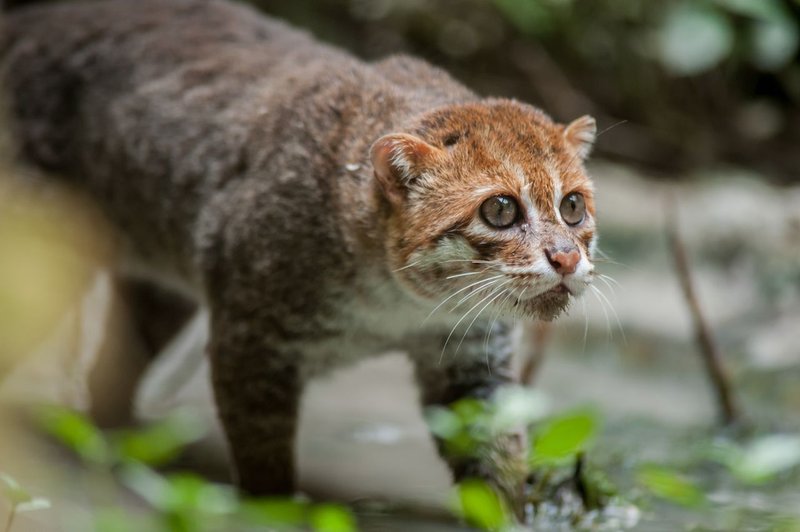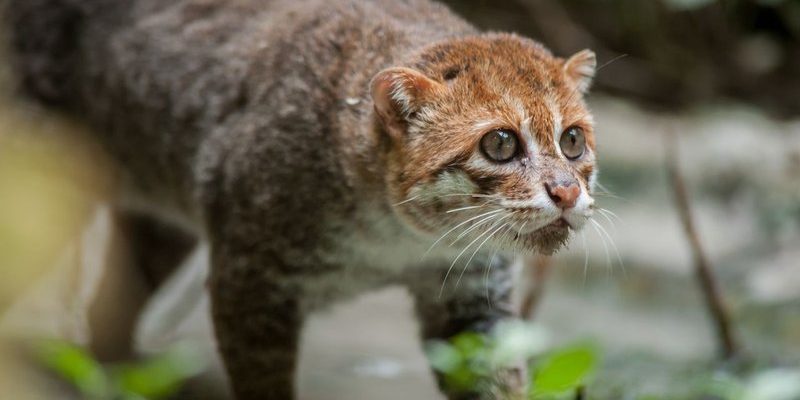
The Flat-Headed Cat is one of those seldom-seen creatures that spark curiosity and intrigue. Imagine a cat that looks a bit like a regular feline but has a distinct, almost pancake-like head. This adorable yet elusive animal is native to the lush wetlands of Southeast Asia, particularly in Malaysia, Thailand, and Indonesia. They dwell in areas close to rivers and swamps, which makes them somewhat hard to spot in the wild.
These cats are not just peculiar in appearance; they also have unique behaviors and characteristics that set them apart from more familiar domestic cats. You might be wondering why they’re so rare. Unfortunately, habitat loss and poaching have decimated their populations over the years. That’s why learning about the Flat-Headed Cat is crucial—not just for cat lovers but for anyone interested in wildlife conservation. It’s a reminder of the delicacy of our ecosystem and the fantastic creatures that inhabit it.
Physical Characteristics
When it comes to looks, the Flat-Headed Cat is stunningly unique. Their heads are flatter than those of most cats, which is an interesting adaptation for their life in watery environments. This shape helps them navigate through the wetlands more effectively. The average adult weighs around 5 to 10 pounds and has a body length of approximately 18 to 24 inches, making them relatively small compared to other wild cats. Their soft, dense fur is usually a mix of browns with darker spots, providing excellent camouflage among the reeds and grasses.
You might notice that unlike some of their larger relatives, Flat-Headed Cats have less visible whiskers and shorter faces. These features are thought to help with their stealthiness while hunting. Their legs are surprisingly long in proportion to their bodies, allowing them to move swiftly and gracefully across muddy surfaces. Isn’t it fascinating how nature crafts adaptations like this to ensure survival?
Habitat and Distribution
The Flat-Headed Cat calls the tropical wetlands of Southeast Asia home, primarily thriving in regions of Malaysia, Thailand, and Indonesia. These regions offer a mix of rivers, swamps, and grasslands—ideal settings for this cat species. Interestingly, they prefer low-lying areas with dense vegetation, which provides both shelter and hunting grounds. While they are incredibly adaptable, their habitat is under severe threat due to deforestation and urban development.
It’s important to understand that these cats are primarily nocturnal hunters. They spend their nights prowling through the tall grasses, using their sharp eyesight to detect prey. During the day, they often retreat into the underbrush or the water to stay cool and hidden from potential threats. The unique combination of their physical traits and habitat needs underscores the delicate balance these animals maintain in their ecosystems.
Diet and Hunting Behavior
The diet of the Flat-Headed Cat is as intriguing as its appearance. These clever felines primarily feast on fish, crustaceans, and small amphibians, which they catch using their agile swimming skills. Their flattened head comes in handy here, allowing them to submerge themselves while keeping a steady eye out for prey. Imagine being able to sneak up on dinner while floating quietly in the water—pretty impressive, right?
Unlike many other wild cats that prefer to hunt on land, the Flat-Headed Cat has adapted to a primarily aquatic lifestyle. This means they have developed incredible swimming abilities. They can easily traverse rivers and swampy areas. Their hunting techniques are fascinating; they often wait patiently near the water’s edge for fish to swim by before pouncing with speed. Observing these cats in action is like watching a beautifully choreographed dance of nature.
Conservation Status
Sadly, the Flat-Headed Cat is classified as critically endangered, primarily due to habitat destruction and illegal hunting. As urbanization expands, much of their wetland habitats are being drained or converted for agriculture. This loss not only affects the Flat-Headed Cat but also disrupts the entire ecosystem that depends on these wetlands. Conservationists are working tirelessly to raise awareness, protect these habitats, and curb illegal activities that threaten their existence.
Various organizations are also focused on breeding programs to help boost their populations in captivity, with hopes of introducing them back into the wild. Every little effort counts when it comes to saving this unique species. You might be asking yourself how you can help—spreading the word about the Flat-Headed Cat and supporting conservation efforts can make a big difference!
Behavior and Social Structure
Flat-Headed Cats are generally solitary creatures. They prefer to roam and hunt alone, which is common among many wild cats. However, during mating season, they may come together briefly. They communicate through vocalizations and scent markings, marking their territories with urine or scratch marks on trees and logs. These behaviors might seem familiar if you’ve ever observed your domesticated cat.
While not much research is available on their mating habits, it is known that the female typically gives birth to 2-4 kittens after a gestation period of about 70 days. The kittens are born blind and dependent on their mother for survival, much like domestic kittens. Mothers are very protective, and this nurturing behavior helps ensure that the young ones learn the skills necessary to thrive in their challenging environment.
Interesting Facts
| Common Name: | Flat-Headed Cat |
| Scientific Name: | Prionailurus planiceps |
| Size: | 18-24 inches long |
| Weight: | 5-10 pounds |
| Habitat: | Tropical wetlands, rivers, and swamps |
| Diet: | Fish, crustaceans, small amphibians |
| Lifespan: | Up to 15 years in captivity |
How You Can Help
Now that you know about the Flat-Headed Cat and its struggles, you might wonder how you can get involved. Here are a few suggestions:
- Spread Awareness: Talk to friends and family about these amazing creatures. The more people know, the more support there will be for conservation efforts.
- Support Conservation Organizations: Many organizations focus on preserving habitats and endangered species. Donations or volunteering can make a real impact.
- Be Eco-Conscious: Make choices that reduce your environmental footprint—like using less plastic and supporting sustainable products.
FAQ
What is the Flat-Headed Cat’s primary habitat?
The Flat-Headed Cat primarily inhabits tropical wetlands, rivers, and swamps in Southeast Asia. These environments provide them with the cover and resources they need to thrive, including access to water for hunting.
Are Flat-Headed Cats social animals?
Generally, Flat-Headed Cats are solitary creatures. They typically roam alone and establish their own territories, communicating through scent markings and vocalizations, especially during mating season.
How does the Flat-Headed Cat hunt?
These cats are expert hunters, primarily preying on fish and small aquatic animals. Their unique adaptations allow them to swim efficiently, enabling them to catch prey while remaining stealthy.
What are the main threats to the Flat-Headed Cat?
The main threats include habitat loss due to deforestation and urbanization, as well as poaching for the illegal wildlife trade. These factors have led to a significant decline in their population.
How long do Flat-Headed Cats live?
In captivity, Flat-Headed Cats can live up to 15 years. However, their lifespan in the wild may be shorter due to factors like predation, competition, and environmental changes.
Are Flat-Headed Cats good swimmers?
Yes, Flat-Headed Cats are excellent swimmers! Their long limbs and streamlined bodies allow them to move swiftly through water, making them highly effective hunters in their wetland habitats.
What conservation efforts are in place for Flat-Headed Cats?
Various organizations are working on breeding programs, habitat protection, and raising awareness about the Flat-Headed Cat’s plight. Support for these initiatives is crucial to help boost their population and protect their environment.
Can Flat-Headed Cats be kept as pets?
Flat-Headed Cats are wild animals and not suitable as pets. They have specialized needs and behaviors that cannot be easily accommodated in a domestic setting. Conservation of their natural habitats is essential for their survival.
What do Flat-Headed Cats eat?
These cats primarily consume fish, crustaceans, and small amphibians. Their diet is heavily influenced by the availability of food in their aquatic habitats.
How can I help with conservation efforts?
You can help by raising awareness, supporting conservation organizations financially or with your time, and making environmentally conscious choices in your daily life to reduce habitat destruction!
Where can I learn more about Flat-Headed Cats?
Many wildlife conservation websites and programs provide information about Flat-Headed Cats, their habitats, and current conservation efforts. Checking out reputable wildlife organizations can be a good start!
What is the scientific name of the Flat-Headed Cat?
The scientific name for the Flat-Headed Cat is Prionailurus planiceps. Understanding this helps in identifying the species within the broader context of wild cats.
Why are Flat-Headed Cats endangered?
Their endangered status primarily stems from habitat destruction due to agriculture and urbanization, as well as poaching. Increased awareness and action can help protect these unique creatures.

